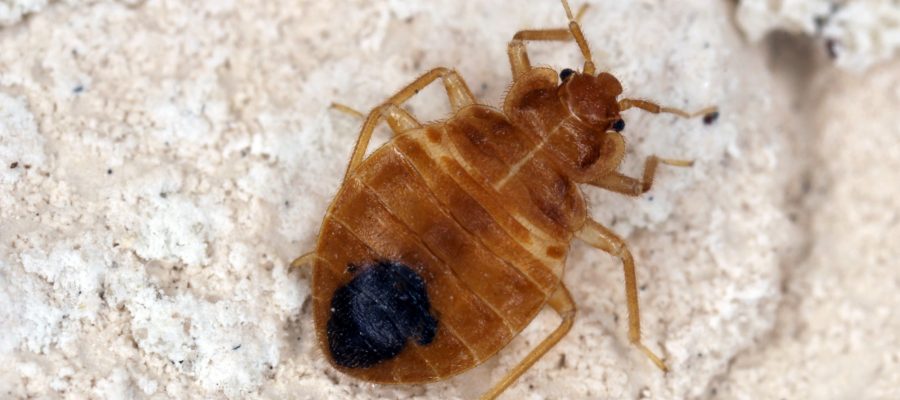Identifying the Different Types of Bed Bugs
- November 11, 2020
- in Pest Control
- by Ashley Dando

Even the words “bed bugs” can leave you feeling itchy and shivering in revulsion. If you’re affected, no doubt you want to get rid of bed bugs in your home or business ASAP. However, you should be aware that there are different types of bed bugs.
What difference do bed bug types make anyway?
Well, it matters because some types are immune to certain treatments. If we don’t identify the type, you might never be rid of the tiny biting nuisances.
Bedbugs are tiny, parasitic insects that are about the size of an apple seed. Parasitic means they feed off the blood of other creatures. Some prefer humans while others go for animals or birds as their victims. They like to hide in the crevices of mattresses, box springs, headboards, and bed frames.
You generally notice bed bugs at night when they start biting as you sleep. Bed bugs can be a problem in homes but are also common in places that have a high turnover of people who use the beds. This can include commercial properties and buildings like hotels, hospitals, and homeless shelters.
It can sometimes be difficult to tell if you have an infestation sometimes. It’s easy to contribute the itchy welts to other pests like mosquitoes or fleas.
You might not notice bedbugs biting at night since the bites don’t hurt. However, you will develop small, itchy welts later on. The welts can show up anywhere on exposed skin, whereas flea bites generally show up on your ankles and feet.
Signs of a bedbug infestation:
Sometimes the only way to know if you have bed bugs is to find them and identify the type.
There are five kinds of bed bugs, however, not all of them feed on humans. Again, you need to identify the type so you can know how to treat for them.
As the name implies, common bed bugs (cinmex lecularius) are very common. They live mainly in temperate regions around the world, including Europe, Northern Asia, and North and Central America.
What they look like:
They do not transfer disease but can cause skin infections and irritation.
Tropical Bed Bugs (cimex hemipterus) also feed on human blood. As the name implies, this type is found in tropical regions of the world, including the Equator, parts of North and South America, Africa, Asia, and Australia.
What they look like:
This type of bed bedbug has shown up in sub-tropical regions like Florida in the United States.
Called “cimex adjuntus”, these are similar to common bed bugs, however, they feed on bats. They don’t generally go for humans, so if you have them in your home, chances are you also have bats somewhere.
Bat bed bugs can show up in mattresses, box springs, and headboards, but they also dwell in ceilings, attics, wall spaces, chimneys, and uninhabited buildings.
What they look like:
Due to their similar appearance, they are often mistaken for common bed bugs. Sometimes only a trained professional will be able to tell the difference.
It’s not surprising that the Mexican Chicken Bug (Haematosiphon) infests in places where poultry is kept. You’ll find them around hens, as well as turkeys, domestic fowl, hawks, and eagles.
They have a similar look to the common bed bug, but of course, their habits are different.
This type of bed bug is found around nests in barns and cliff sallow nests. You can also find them in buildings like hotels and homes where the birds nest.
What they look like:
Like other types of bed bugs, they don’t generally feed on humans, but they might if their primary food source isn’t around.
If you think there’s an infestation in your home or business, there are some things you can do to get rid of bed bugs.
First, identify the infested areas. If you can catch the infestation early (before the bed bugs have reproduced) you have a much better chance.
Use a flashlight so you can see all of these areas clearly. A magnifying glass will help, too.
If you find an infestation, it’s time to clean. Vacuum the carpets and then seal up the vacuum bag tightly and throw it out. Wash all bed linens, blankets, comforters, and throws in the highest possible temperature setting in both the washer and dryer.
Once you’ve done all of that, you may still need professional help from an exterminator.
If you’ve found an infestation of bed bugs, and perhaps identified the types of bed bugs, do whatever it takes to get rid of them. They might not spread disease, but the angry, red welts they produce can be irritating.
Plus, who wants nasty bed bugs around their family? Their guests? Their patients?
Call the professionals at Safeguard Pest Control to help. We offer bed bug control services for residential homes and apartment buildings, and commercial properties, including hotels, hospitals, childcare centers/schools, restaurants, government buildings, and food processing centers.
Array